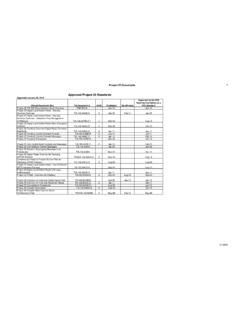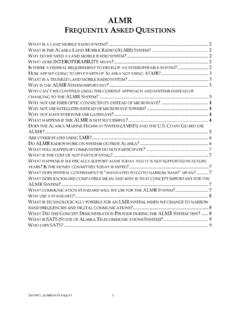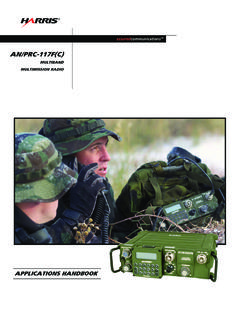Transcription of LMR AND THE P25 SUITE OF STANDARDS - Project …
1 D E F E N D IN G W O R L D S E CU RI T Y. LMR AND THE P25 SUITE OF STANDARDS . Interoperable, Wireless Communications for the public safety Industr y Main Features The use of licensed RF spectrum versus walkie-talkie APCO (Association of public safety Communications communications which use unlicensed spectrum Officials) organization and is published and administered Simplex communications only one speaker on an audio by the Telecommunications Industry Association (TIA). channel at one time STANDARDS body. The P25 SUITE of STANDARDS was developed to address a number of spectrum and interoperability issues Push-To-Talk (PTT) signaling a Land Mobile Radio (LMR) user depresses and holds down a PTT button related LMR radio communications. before and during speech to transmit audio The Federal Communications Commission's (FCC). mandate to improve radio spectrum efficiency LMR is a broad term that encompasses all licensed two- The need to implement voice processing and advances way, push-to-talk mobile radio communications.
2 LMR in digital technologies and modulation techniques that communications systems are intended for use by terrestrial improve voice quality users in vehicles (mobiles) or on foot (portables). LMR systems The many proprietary implementations of APCO Project are used by emergency first responder organizations, public 16 and earlier LMR solutions that restricted component works organizations or companies with large vehicle fleets or interoperability and competition numerous field staff to communicate quickly and efficiently with The requirement for effective, efficient, and reliable other users on the system. intra- and inter-agency communications The growing emphasis on encryption and data Project 25 (P25) refers to a SUITE of STANDARDS for digital radio communications that has become the de facto standard for public safety radio systems in North America. The P25. STANDARDS SUITE was developed under the guidance of the LMR and the P25 SUITE of STANDARDS P25 System Definitions P25 Open Interfaces The P25 SUITE of STANDARDS has defined three types of An open P25 interface connects one network component with systems Phase 0, Phase 1 and Phase 2 systems.
3 Another. The P25 standard defines the electrical characteristics the connection must have, the signals that will be sent between Phase 0 Systems Phase 0 analog systems are used the components over the connection, and what each signal by public safety entities (and others) in bandwidths will mean. The P25 SUITE of STANDARDS specifies eight open ranging from KHz to 30 KHz. The common elements of these systems are FM analog modulation interfaces between the various components of an LMR system. and analog-based signaling techniques such as CTCSS and CDCSS Common Air Interface (CAI) CAI specifies the type and content of signals transmitted by compliant radios. One Phase 1 Systems Phase 1 systems are defined by the radio using CAI should be able to communicate with any TIA102 series of the P25 standard documents. The other CAI radio, regardless of the manufacturer earliest standard documents were related to the CAI. (Common Air Interface) using the following Subscriber Data Peripheral Interface (SDPI) SDPI specifies technologies: the port through which mobiles and portables can connect to laptops or data networks Frequency Division Multiple Access (FDMA).
4 Spectrum which is divided into channels, each Fixed Station Interface (FSI) FSI describes the signaling carrying one voice path and messages between the P25 RF Subsystem (RFSS) and a conventional fixed station KHz channel spacing which generally uses 25. or 30 KHz and is twice as efficient as traditional Console Subsystem Interface (CSI) Similar to the fixed analog channels station interface, CSI defines the signaling and messages C4FM modulation scheme which enables 9600 between the P25 RFSS and the console subsystem bps to be transmitted on a KHz channel Network Management Interface (NMI) NMI allows Improved Multi-Band Excitation (IMBE) vocoder administrators to control and monitor network fault which enables speech to be digitally represented management and network performance management using a bandwidth of 4400 bps Data Network Interface (DNI) DNI specifies the P25 RFSS. Phase 2 Systems Phase 2 systems represent the connections to computers, data networks or external data next step in the migration process to achieve sources improved spectrum efficiency, with a 4:1 voice path spectrum utilization improvement over the original 25 Telephone Interconnect Interface (TII) The TII interface KHz FDMA technologies.
5 Phase 2 Time Division between the RFSS and the public Switched Telephone Multiple Access (TDMA) systems comply with the Network (PSTN) allows field personnel to use radios rather FCC's voice spectrum efficiency rule of one voice than cell phones to make connections through the PSTN. path per KHz equivalent bandwidth providing Inter RF Subsystem Interface (ISSI) ISSI permits users in two voice paths in a KHz channel. one system to communicate with users in a different system, from one jurisdiction to another, from one agency to another, and from one city to another Subscriber Data Peripheral Fixed System Data Interface Gateway Interface Interface Databases MDT (FSSI). Common Air PSTN. Interface Telephone (CAI) Interconnect (PSTN). Network Manager Console SubSystem P25 RF Inter RT Interace Subsystem SubSystem Interface (CSSI). (RFSS) (ISSI). Consoles Repeaters System Other P25. Systems LMR and the P25 SUITE of STANDARDS The Advantages of P25 STANDARDS P25 STANDARDS are designed to ease the migration from analog to digital LMR.
6 Systems, and offer a number of advantages over other LMR radio communication technologies. Existing 25 KHz channels can be reorganized into two KHz channels. The same center frequency is used when narrowbanding from 25 KHz to KHz channels Migration is smooth P25-compliant radios can operate in digital or analog mode, and many analog radios are capable of working with P25 systems with simple software upgrades. P25 offers conventional and trunked modes with the basic and advanced functionality required by the geography or user's mode of operation P25 Phase 1 uses the proven FDMA technology that is well understood and extremely reliable P25 Phase 2 uses reliable QPSK modulation for the downlink and a compatible CPM technology for the uplink, allowing efficient reuse of Phase 1 user-device RF front ends.. P25 is an open standard that allows manufacturers to easily license patented technologies P25 is based on open interfaces and support full interoperability allowing users to choose from a wide range of network products and suppliers The Industry Leader A pioneer and trusted leader in mission critical communications, Cassidian Communications, an EADS North America Company, provides key technologies for public safety , federal and corporate markets.
7 Our full-circle security and communications portfolio includes 9-1-1 call center CTI applications for call processing, CAD, mapping and information management, as well as managed services, notification solutions and services and P25 Land Mobile Radio networks. Headquartered in Temecula, California. Cassidian Communications HEADQUARTERS GATINEAU OFFICE FRANKLIN OFFICE FRISCO OFFICE. 42505 Rio Nedo 75 Blvd. de la Technologie 117 Seaboard Lane, SUITE D-100 6801 Gaylord Parkway, SUITE 305. Temecula, CA 92590 USA Gatineau, QC J8Z 3G4 Canada Franklin, TN 37067 USA Frisco, TX 75034 USA. Telephone: Telephone: Telephone: Telephone: 0112. Toll Free: Fax: Toll Free: Toll Free: Fax: Fax: Fax: CCINC-LMRP25. Copyright 2012 Cassidian Communications, Inc. All rights reserved. This literature is for informational purposes only. All trademarks, service marks, product names, brands, company names and logos appearing in this literature are the property of their respective owners. This literature is provided AS IS without warranty of any kind.
8 Cassidian Communications hereby disclaims all warranties and conditions with regard to this literature, including all express and implied warranties.








